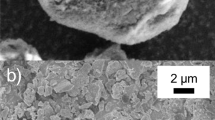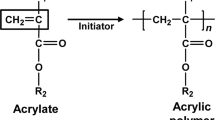Abstract
Water-based acrylic pressure-sensitive adhesives (PSA) are a common component of disposable products such as tapes, labels, and packaging. Such adhesives are generated from fossil-derived monomers and additives and persist in the environment due to their low biodegradability. Furthermore, they can interfere with the recycling and remediation of products they interact with, such as plastic and paper products. Although touted as a promising remedy to these issues, adhesive polymers generated using renewable and degradable monomers tend to fall short regarding performance and cost. This study reports on the fungal degradation behaviors of hybrid PSAs copolymerized mainly from traditional acrylics and lactide-based macromonomers. These structures provide high performance at a reasonable cost and represent an alternative approach to addressing environmental concerns. Evaluating the biodegradability of these hybrid PSAs involved solid and liquid cultures using 53 unique fungal species. Nearly 50% (n = 23) of the screened species showed PSA-degrading capacities of varying degrees, including Trametes versicolor and Pestalotiopsis microspora, providing roughly complete (> 96%) polymer removal in liquid cultures. Fungal degradation of cast adhesive films was monitored using evolved CO2 and mass loss and confirmed through scanning electron microscopy and spectral analysis (FTIR). Enzyme assays, namely laccases, lipases, and proteases, showed a high correlation with the observed biodegradation rates, suggesting that hydrolytic and oxidative enzymes were likely factors driving latex degradation. These results demonstrate that the high-performing hybrid formulation is degradable by fungi. While a portion of the studied adhesive was synthesized using petroleum-derived monomers, this could serve as a bridge technology, hel** to usher in more sustainable disposable consumer products until a time comes when all components are renewably sourced.





Similar content being viewed by others
References
Chazovachii PT, Somers MJ, Robo MT et al (2021) Giving superabsorbent polymers a second life as pressure-sensitive adhesives. Nat Commun 12:4524. https://doi.org/10.1038/s41467-021-24488-9
Gaytán I, Burelo M, Loza-Tavera H (2021) Current status on the biodegradability of acrylic polymers: microorganisms, enzymes and metabolic pathways involved. Appl Microbiol Biotechnol 105:991–1006. https://doi.org/10.1007/s00253-020-11073-1
Pu G, Hauge DA, Gu C et al (2013) Influence of acrylated lactide-caprolactone macromonomers on the performance of high biomass content pressure-sensitive adhesives. Macromol React Eng 7:515–526. https://doi.org/10.1002/mren.201300160
Droesbeke MA, Aksakal R, Simula A et al (2021) Biobased acrylic pressure-sensitive adhesives. Prog Polym Sci 117:101396. https://doi.org/10.1016/j.progpolymsci.2021.101396
Lim BKH, Thian ES (2022) Biodegradation of polymers in managing plastic waste—a review. Sci Total Environ 813:151880. https://doi.org/10.1016/j.scitotenv.2021.151880
Sankhla IS, Sharma G, Tak A (2020) Chapter 4 -Fungal degradation of bioplastics: An overview. In: Singh J, Gehlot P (eds) New Futur. Dev. Microb. Biotechnol. Bioeng, p 35–47. https://doi.org/10.1016/B978-0-12-821007-9.00004-8
Tyagi P, Agate S, Velev OD et al (2022) A critical review of the performance and soil biodegradability profiles of biobased natural and chemically synthesized polymers in industrial applications. Environ Sci Technol 56:2071–2095. https://doi.org/10.1021/acs.est.1c04710
Ahmad A, Banat F, Alsafar H, Hasan SW (2022) An overview of biodegradable poly (lactic acid) production from fermentative lactic acid for biomedical and bioplastic applications. Biomass Convers Biorefinery. https://doi.org/10.1007/s13399-022-02581-3
Kliem S, Kreutzbruck M, Bonten C (2020) Review on the biological degradation of polymers in various environments. Mater Basel Switz. https://doi.org/10.3390/ma13204586
Jutinico-Shubach LM, Castaño JD, Juarez T et al (2022) A novel basydiomycete isolated from mangrove swamps in the Colombian Caribbean shows promise in dye bioremediation. Bioremediation J 26:179–197. https://doi.org/10.1080/10889868.2021.1964426
Castaño JD, Crespo CC, Torres E (2019) Evaluation of chemical and biological treatments to degrade oil palm empty fruit bunches (Elaeis guineensis Jacq.) and their potential use. J Oil Palm Res 31:271–280. https://doi.org/10.21894/jopr.2019.0016
Balaji V, Arulazhagan P, Ebenezer P (2014) Enzymatic bioremediation of polyaromatic hydrocarbons by fungal consortia enriched from petroleum contaminated soil and oil seeds. J Environ Biol 35:521–529
Srikanth M, Sandeep TSRS, Sucharitha K, Godi S (2022) Biodegradation of plastic polymers by fungi: a brief review. Bioresour Bioprocess 9:42. https://doi.org/10.1186/s40643-022-00532-4
Castaño JD, Muñoz-Muñoz N, Kim YM et al (2022) Metabolomics highlights different life history strategies of white and brown rot wood-degrading fungi. Msphere 7:e00545-22. https://doi.org/10.1128/msphere.00545-22
Schilling JS, Kaffenberger JT, Held BW et al (2020) Using wood rot phenotypes to illuminate the “gray” among decomposer fungi. Front Microbiol. https://doi.org/10.3389/fmicb.2020.01288
Zhang J, Presley GN, Hammel KE et al (2016) Localizing gene regulation reveals a staggered wood decay mechanism for the brown rot fungus Postia placenta. Proc Natl Acad Sci 113:10968–10973. https://doi.org/10.1073/pnas.1608454113
Zhang J, Silverstein KA, Castaño JD et al (2019) Gene regulation shifts shed light on fungal adaption in plant biomass decomposers. mBio 10:e02176-19. https://doi.org/10.1128/mBio.02176-19
Castaño JD, Zhang J, Anderson CE, Schilling JS (2018) Oxidative damage control during decay of wood by brown rot fungus using oxygen radicals. Appl Environ Microbiol 84:e01937-e2018. https://doi.org/10.1128/AEM.01937-18
Corti A, Sudhakar M, Chiellini E (2012) Assessment of the whole environmental degradation of oxo-biodegradable linear low density polyethylene (LLDPE) films designed for mulching applications. J Polym Environ 20:1007–1018. https://doi.org/10.1007/s10924-012-0493-7
da Luz JMR, Paes SA, Nunes MD et al (2013) Degradation of oxo-biodegradable plastic by pleurotus ostreatus. PLoS ONE 8:e69386
DelRe C, Jiang Y, Kang P et al (2021) Near-complete depolymerization of polyesters with nano-dispersed enzymes. Nature 592:558–563. https://doi.org/10.1038/s41586-021-03408-3
Huang Q, Hiyama M, Kabe T et al (2020) Enzymatic self-biodegradation of poly(l-lactic acid) films by embedded heat-treated and immobilized proteinase K. Biomacromolecules 21:3301–3307. https://doi.org/10.1021/acs.biomac.0c00759
Richert A, Dąbrowska GB (2021) Enzymatic degradation and biofilm formation during biodegradation of polylactide and polycaprolactone polymers in various environments. Int J Biol Macromol 176:226–232. https://doi.org/10.1016/j.ijbiomac.2021.01.202
Castaño JD, Cruz C, Torres E (2015) Optimization of the production, purification and characterization of a laccase from the native fungus Xylaria sp. Biocatal Agric Biotechnol 4:710–716. https://doi.org/10.1016/j.bcab.2015.09.012
Liu Q, Sun S, Piao M, Yang JY (2013) Purification and characterization of a protease produced by a Planomicrobium sp. L-2 from gut of Octopus vulgaris. Prev Nutr Food Sci 18:273–279. https://doi.org/10.3746/pnf.2013.18.4.273
Kumar S, Kikon K, Upadhyay A et al (2005) Production, purification, and characterization of lipase from thermophilic and alkaliphilic Bacillus coagulans BTS-3. Protein Expr Purif 41:38–44. https://doi.org/10.1016/j.pep.2004.12.010
Babicki S, Arndt D, Marcu A et al (2016) Heatmapper: web-enabled heat map** for all. Nucleic Acids Res 44:W147–W153. https://doi.org/10.1093/nar/gkw419
Alzola C, Harrell F (2002) An Introduction to S And the Hmisc and Design Libraries. (https://cran.r-project.org/doc/contrib/Alzola+Harrell-Hmisc-Design-Intro.pdf)
Pu G, Dubay MR, Zhang J et al (2012) Polyacrylates with high biomass contents for pressure-sensitive adhesives prepared via mini-emulsion polymerization. Ind Eng Chem Res 51:12145–12149. https://doi.org/10.1021/ie301492v
Tokiwa Y, Calabia BP, Ugwu CU, Aiba S (2009) Biodegradability of plastics. Int J Mol Sci 10:3722–3742. https://doi.org/10.3390/ijms10093722
Russell JR, Huang J, Anand P et al (2011) Biodegradation of polyester polyurethane by endophytic fungi. Appl Environ Microbiol 77:6076–6084. https://doi.org/10.1128/AEM.00521-11
Mohan AJ, Sekhar VC, Bhaskar T, Nampoothiri KM (2016) Microbial assisted high impact polystyrene (HIPS) degradation. Int Conf New Horiz Biotechnol NHBT-2015 213:204–207. https://doi.org/10.1016/j.biortech.2016.03.021
Tachibana Y, Baba T, Kasuya K (2017) Environmental biodegradation control of polymers by cleavage of disulfide bonds. Polym Degrad Stab 137:67–74. https://doi.org/10.1016/j.polymdegradstab.2017.01.003
Sarno A, Olafsen K, Kubowicz S et al (2021) Accelerated hydrolysis method for producing partially degraded polyester microplastic fiber reference materials. Environ Sci Technol Lett 8:250–255. https://doi.org/10.1021/acs.estlett.0c01002
Pradhan S, Mohanty S, Nayak SK (2018) In-situ aerobic biodegradation study of epoxy-acrylate film in compost soil environment. J Polym Environ 26:1133–1144. https://doi.org/10.1007/s10924-017-1021-6
Qi X, Ma Y, Chang H et al (2021) Evaluation of PET degradation using artificial microbial consortia. Front Microbiol. https://doi.org/10.3389/fmicb.2021.778828
Yongrui P, Zheng Z, Bao M et al (2015) Treatment of partially hydrolyzed polyacrylamide wastewater by combined Fenton oxidation and anaerobic biological processes. Chem Eng J 273:1–6. https://doi.org/10.1016/j.cej.2015.01.034
Mohanan N, Montazer Z, Sharma PK, Levin DB (2020) Microbial and enzymatic degradation of synthetic plastics. Front Microbiol 11:580709
Mukherjee S, Roy Chowdhuri U, Kundu PP (2016) Bio-degradation of polyethylene waste by simultaneous use of two bacteria: Bacillus licheniformis for production of bio-surfactant and Lysinibacillus fusiformis for bio-degradation. RSC Adv 6:2982–2992. https://doi.org/10.1039/C5RA25128A
Dwivedi UN, Singh P, Pandey VP, Kumar A (2011) Structure–function relationship among bacterial, fungal and plant laccases. J Mol Catal 68:117–128. https://doi.org/10.1016/j.molcatb.2010.11.002
Agustin MB, de Carvalho DM, Lahtinen MH et al (2021) Laccase as a tool in building advanced lignin-based materials. Chemsuschem 14:4615–4635. https://doi.org/10.1002/cssc.202101169
Biundo A, Braunschmid V, Pretzler M et al (2020) Polyphenol oxidases exhibit promiscuous proteolytic activity. Commun Chem 3:62. https://doi.org/10.1038/s42004-020-0305-2
Funding
This work is supported by a University of Minnesota, MnDRIVE Postdoc Seed Grant, Project ID MESG-0000000150. J.Z. was also supported by the startup funds at the University of Minnesota.
Author information
Authors and Affiliations
Contributions
JDC, DAH, SJS, and JZ designed research. JDC performed the biodegradation experiments. DAH synthesized the PSA latex and film. AH measured biodegradation rates at different macromonomer concentrations. JDC and JZ organized the data, made figures and tables, and wrote the paper. SJS and DAH revised and commented on the manuscript writing. All authors made comments on the manuscript and approved the final version.
Corresponding authors
Ethics declarations
Conflict of interest
The authors declare that they have no known competing financial interests or personal relationships that could have appeared to influence the work reported in this paper.
Additional information
Publisher's Note
Springer Nature remains neutral with regard to jurisdictional claims in published maps and institutional affiliations.
Supplementary Information
Below is the link to the electronic supplementary material.
Rights and permissions
Springer Nature or its licensor (e.g. a society or other partner) holds exclusive rights to this article under a publishing agreement with the author(s) or other rightsholder(s); author self-archiving of the accepted manuscript version of this article is solely governed by the terms of such publishing agreement and applicable law.
About this article
Cite this article
Castaño, J.D., Hauge, D.A., Haag, A. et al. Fungal Biodegradation of a Hybrid Adhesive Polymer Containing High-Biomass Content. J Polym Environ 31, 5234–5244 (2023). https://doi.org/10.1007/s10924-023-02938-3
Accepted:
Published:
Issue Date:
DOI: https://doi.org/10.1007/s10924-023-02938-3




